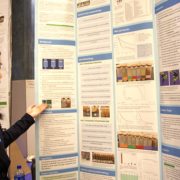Students Showcase Innovation in Water Technology
Middle and high school students from San Diego and Imperial counties showcased their creativity and innovation in water technology at the Greater San Diego Science and Engineering Fair.
Winning students at the March event presented multi-faceted water technology designed for use in agriculture, water conservation, safety and treatment, creating solutions to some of the San Diego region’s most pressing water issues.
For decades, the San Diego County Water Authority has partnered with the Greater San Diego Science and Engineering Fair to inspire students to pursue water industry careers and experiment with sustainable water designs.
High school students invent next-generation water technology
Kyle Tianshi and Sarah Gao tied for first place in the senior division for their development of water purifying technologies. Tianshi, an eleventh grader at The Cambridge School, focused on water pollutant identification through light scattering. Tianshi said the project used fluorescent emissions and lasers to detect microplastics in drinking water.
Gao’s work with wastewater treatment experimented with plant seeds as flocculants for water purification. A Canyon Crest Academy sophomore, Gao was also named an ISEF finalist for her work and will compete in the Regeneron International Science and Engineering Fair in Dallas, Texas in May.
Srija Sengupta from Westview High School took home the second-place senior award for her project, “Good on Land and Bad in Water: Effects of Fertilizer-Rich Runoff on Algal Growth.” Sengupta’s research tested the effects of fertilizer runoff in Dixon Lake and the subsequent impact on marine life, finding that phosphorous-rich fertilizers contributed the most to algae growth.
Middle school students ‘wow’ with work in water technology
In the junior division, Ryan Richardson was awarded first place for his automatic faucet invention. When tested, Richardson’s faucet was found to save more than 50% of water in a household of four, prioritizing water conservation. He is already pursuing a patent for his invention.
From Saint Gregory the Great Catholic School, seventh graders Joaquin Revilla Harker and Tyler Rowe earned the second-place junior division title. Harker and Rowe’s research tested the growth capabilities of different water on grass, finding that gray water was the most suitable for growth, which can help conserve drinking water.
Caleb Raagas, who is also a seventh grader at Saint Gregory the Great Catholic School, was awarded the junior division’s third place award for his research on the effects of salinity levels on the production of hydroelectricity.
“This year’s winners all developed projects that address or could help solve a critical issue related to water, such as water quality, water supply management, and water purification,” said Sami Sweis, Engineer P.E. at the Water Authority. “Our industry needs bright young people like these students to use cutting-edge technology and innovation to help maintain safe and reliable water supplies for generations to come.”
Welcoming future environmental innovators
There are more than 2,800 professionals in the water and wastewater industry in San Diego County, who work hard to provide safe and reliable water supplies to the region. The Water Authority’s continued partnerships with the community work to guarantee a future of opportunity for students interested in being a part of this industry.



